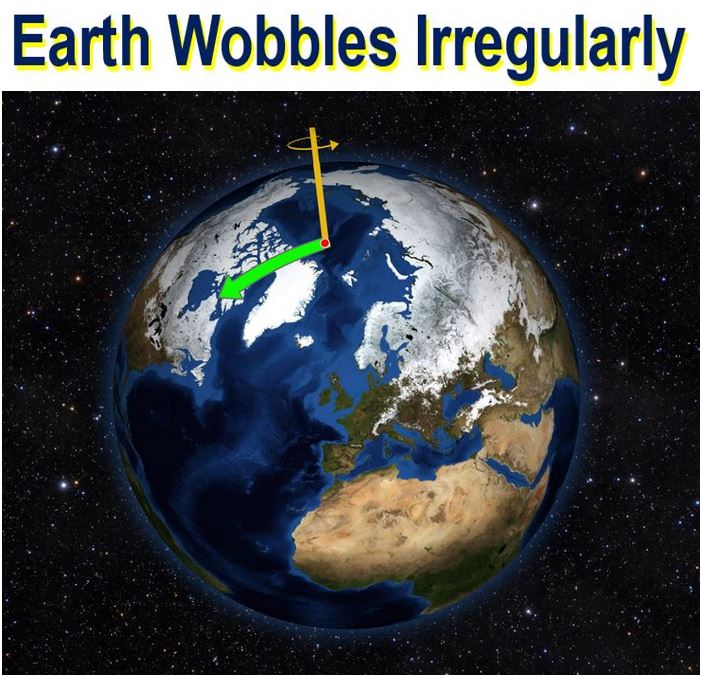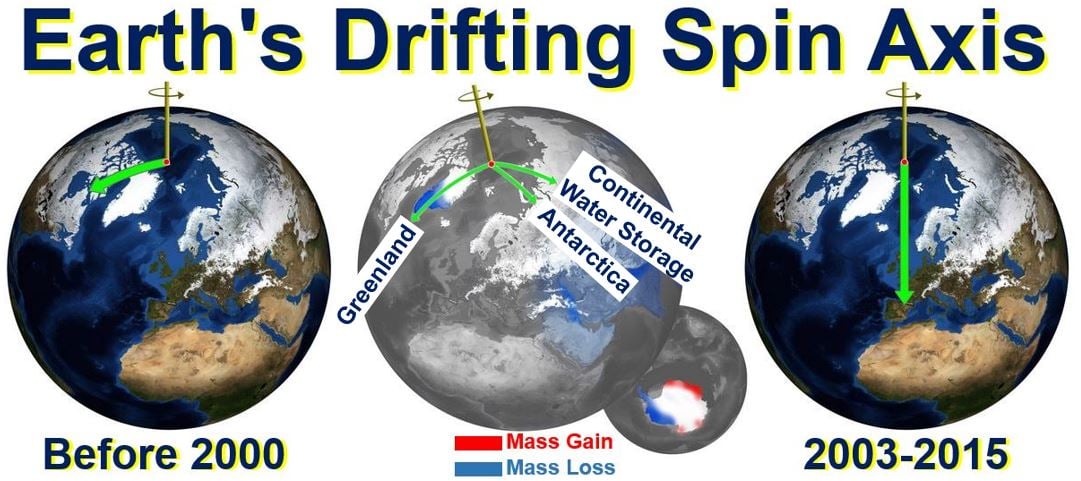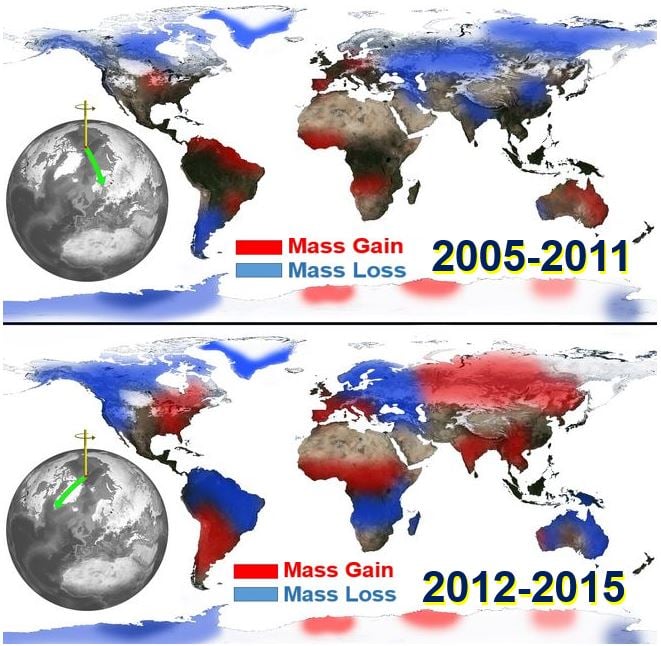At the turn of the century, the spin axis of Earth took an abrupt turn eastwards and is currently drifting nearly twice as fast as before, at a rate of 17 centimetres (7 inches) per year, partly due to the loss of ice from Greenland and Antarctica and changes in water mass on land in Eurasia, says a team of scientists from NASA’s Jet Propulsion Laboratory (JPL), Pasadena, California.
Regarding Earth’s axis, Surendra Adhikari, a post-doctoral affiliate at JPL, said:
“It’s no longer moving toward Hudson Bay, but instead toward the British Isles. That’s a massive swing.”
 Earth wobbles irregularly over time, which means it does not always spin on an axis running through its poles. Its axis has been drifting towards North America during most of the last century (green arrow). That direction has changed dramatically due to changes in water mass on Earth. (Image: NASA/JPS-Caltech)
Earth wobbles irregularly over time, which means it does not always spin on an axis running through its poles. Its axis has been drifting towards North America during most of the last century (green arrow). That direction has changed dramatically due to changes in water mass on Earth. (Image: NASA/JPS-Caltech)
Dr. Adhikari and Erik Ivins, a senior research scientist at JPL, have written about their research and findings in the academic journal Science Advances (citation below).
Two Earth-wobble mysteries solved
Using satellite data on how water moves around our planet, they say they have solved two mysteries about wobbles in Earth’s rotation – one new and the other more than 100 years old.
The authors say their research may help improve our knowledge of past and future climate.
While a desktop globe always spins smoothly around the axis running through its south and north poles, real planets wobble.
Earth’s spin axis is not always at exactly the same spot – it drifts slowly around the two poles. According to observations, the axis has shifted about 12 metres (37 feet). There is no need to panic, our lives will not be affected by this drift, but we have to measure them in order to get accurate results from Earth-observing satellites, GPS and observatories on the ground.
 Prior to 2000, Earth’s spin axis was drifting toward Canada (green arrow, left globe). Scientists calculated the effect of changes in water mass in different regions (center globe) in pulling the direction of drift eastward and speeding up the rate (right globe). (Image: NASA/JPS-Caltech)
Prior to 2000, Earth’s spin axis was drifting toward Canada (green arrow, left globe). Scientists calculated the effect of changes in water mass in different regions (center globe) in pulling the direction of drift eastward and speeding up the rate (right globe). (Image: NASA/JPS-Caltech)
Doctors Ivins and Adhikari have been researching how the movement of water around our planet contributes to Earth’s rotational wobbles.
Previous studies have detected several connections between processes inside the Earth and on its surface and its wandering ways.
For example, the Earth’s mantle has not completely readjusted to the loss of ice on North America after the last Ice Age – it is still readjusting – and the reduced mass beneath that continent pulls the spin axis towards Canada at a rate of several inches per year. However, some movements are still baffling.
Why has Earth’s spin axis shifted abruptly?
Regarding the theory that since the year 2000 Earth’s spin axis has abruptly shifted to the east because of melting ice in Greenland and Antarctica, the researchers assessed this idea by using observations from the Gravity Recovery And Climate Experiment (GRACE) satellites, a joint mission of NASA and the German Aerospace Center, which provide a monthly record of changes in mass around Earth.
Those changes are mainly caused by movements of water through everyday processes including groundwater depletion and accumulating snowpack.
 The relationship between the east-west wobble in Earth’s spin axis and continental water mass. Water loss from Eurasia corresponds to eastward swings in the general direction of the spin axis (top), and gains in Eurasia push the spin axis westward (bottom). (Image: NASA/JPS-Caltech)
The relationship between the east-west wobble in Earth’s spin axis and continental water mass. Water loss from Eurasia corresponds to eastward swings in the general direction of the spin axis (top), and gains in Eurasia push the spin axis westward (bottom). (Image: NASA/JPS-Caltech)
They calculated how much mass was involved in water cycling between Earth’s land areas and all its oceans between 2003 and 2015, and how much the mass gains and losses pushed and pulled on the spin axis.
Doctors Adhikari and Ivins’ calculations suggested that the melting ice in Greenland alone does not generate the massive amount of energy required to pull the spin axis as far as it has drifted.
On the other side of the world (Southern Hemisphere), ice mass loss from West Antarctica is pulling, while ice mass gain in East Antarctica is pushing Earth’s spin axis in the same direction that Greenland is pulling it from the Northern Hemisphere.
Additional pull coming from Eurasia
However, the combined effect is still not enough to explain the faster shift and new direction. Something else has to be exerting an additional pull, and it must be east of Greenland.
 Surendra Adhikari (left) and Erik Ivin.
Surendra Adhikari (left) and Erik Ivin.
The scientists found where that extra pull was coming from – Eurasia.
Dr. Adhikari said:
“The bulk of the answer is a deficit of water in Eurasia: the Indian subcontinent and the Caspian Sea area.”
They were surprised at the finding. This region has lost water mass due to drought and aquifers, but the loss is considerably less than the change in the ice sheets.
So, why did this smaller loss have such a powerful effect? The authors say it is because the spin axis is extremely sensitive to changes that occur around 45 degrees latitude, both north and south.
Dr. Adhikari explained:
“This is well explained in the theory of rotating objects. That’s why changes in the Indian subcontinent, for example, are so important.”
New solution to a very old problem
While trying to solve this recent enigma, the scientists unexpectedly came up with a promising new solution to an extremely old problem. There is a particular wobble in Earth’s rotation that has baffled experts since observations started in 1899.
Every six to fourteen years, the spin axis wobbles approximately ½ to 1½ metres (20 to 60 inches) either west or east of its general direction of drift.
Dr. Adhikari said:
“Despite tremendous theoretical and modeling efforts, no plausible mechanism has been put forward that could explain this enigmatic oscillation.”
Lining up a graph of the east-west wobble during the period when GRACE data was available against a graph of changes in continental water storage over the same period, the authors detected a startling similarity between the two.
The changes in polar ice appeared to have no association with the wobble – only changes in water on land. For example, dry years in Eurasia corresponded to eastward swings, while westward swings corresponded to wet years.
When the scientists input the GRACE observations on changes in land water mass between April 2002 and March 2015 into classic physics equations that predict pole positions, they found that the results were an almost exact match to the observed east-west wobble.
Dr. Ivins said:
“This is much more than a simple correlation. We have isolated the cause.”
Their discovery raises the possibility that the 115-year record of east-west wobbles in our planet’s spin axis may, in fact, be an extremely good record for changes in land water storage.
Dr. Adhikari said:
“That could tell us something about past climate – whether the intensity of drought or wetness has amplified over time, and in which locations.”
Dr. Ivins said:
“Historical records of polar motion are both globally comprehensive in their sensitivity and extraordinarily accurate. Our study shows that this legacy data set can be used to leverage vital information about changes in continental water storage and ice sheets over time.”
In an Abstract in the journal, the authors wrote:
“This newly discovered link between polar motion and global-scale TWS (terrestrial water storage) variability has broad implications for the study of past and future climate.”
Citation: “Climate-driven polar motion: 2003–2015,” Surendra Adhikari & Erik R. Ivins. Science Advances. 8 April 2016. DOI: 10.1126/sciedv.1501693.
